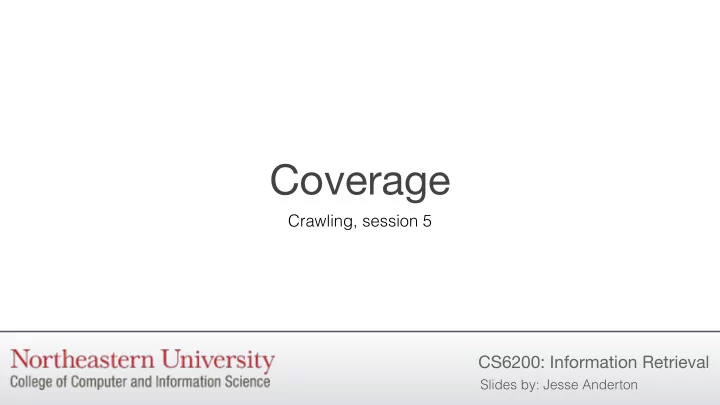

Coverage Crawling, session 5 CS6200: Information Retrieval Slides by: Jesse Anderton
Coverage Goals The Internet is too large and changes too rapidly for any crawler to be able to crawl and index it all. Instead, a crawler should focus on strategic crawling to balance coverage and freshness. A crawler should prioritize crawling high-quality content to better answer user queries. The Internet contains a lot of spam, redundant information, and pages which aren’t likely to be Basic Crawler Algorithm relevant to users’ information needs.
Selection Policies A selection policy is an algorithm used to select the next page to crawl. Standard approaches include: • Breadth-first search : This distributes requests across domains relatively well and tends to download high-PageRank pages early. • Backlink count : Prioritize pages with more in-links from already-crawled pages. • Larger sites first : Prioritize pages on domains with many pages in the frontier. • Partial PageRank : Approximate PageRank scores are calculated based on already-crawled pages. There are also approaches which estimate page quality based on a prior crawl.
Comparing Approaches Baeza-Yates et al compare these approaches to find out which fraction of high quality pages in a collection is crawled by each strategy at various points in a crawl. Breadth-first search does relatively poorly. Larger sites first is among the best approaches, along with “historical” approaches which take PageRank scores from a prior crawl into account. OPIC, a fast approximation to PageRank which can be calculated on the fly, is another good choice. The “omniscient” baseline always fetches the highest PR page in the frontier. Ricardo Baeza-Yates, Carlos Castillo, Mauricio Marin, and Andrea Rodriguez. 2005. Crawling a country: better strategies than breadth-first for web page ordering.
Obtaining Seed URLs It’s important to choose the right sites to initialize your frontier. A simple baseline approach is to start with the sites in an Internet directory, such as http://www.dmoz.org. In general, good hubs tend to lead to many high-quality web pages. These hubs can be identified with a careful analysis of a prior crawl. http://www.dmoz.org
The Deep Web Despite these techniques, a substantial fraction of web pages remains uncrawled and unindexed by search engines. These pages are known as “the deep web.” These pages are missed for many reasons. • Dynamically-generated pages, such as pages that make heavy use of AJAX, rely on web browser behavior and are missed by a straightforward crawl. • Many pages reside on private web sites and are protected by passwords. • Some pages are intentionally hidden, using robots.txt or more sophisticated approaches such as “darknet” software. Special crawling and indexing techniques are used to attempt to index this content, such as rendering pages in a browser during the crawl.
Wrapping Up Good coverage is obtained by carefully selecting seed URLs and using a good page selection policy to decide what to crawl next. Breadth-first search is adequate when you have simple needs, but many techniques outperform it. It particularly helps to have an existing index from a previous crawl. Next, we’ll see how to adjust page selection to favor document freshness.
Recommend
More recommend